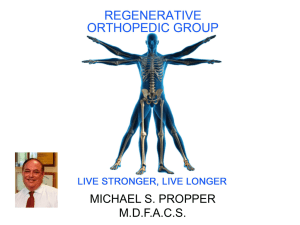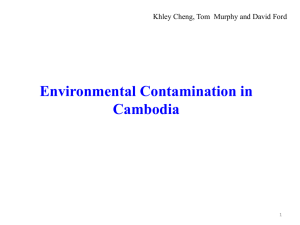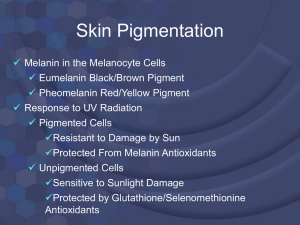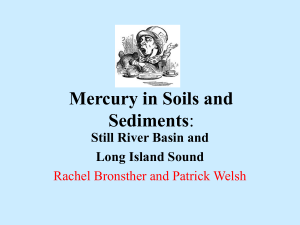Genetic influences on the retention of inorganic mercury. - CLU-IN
advertisement
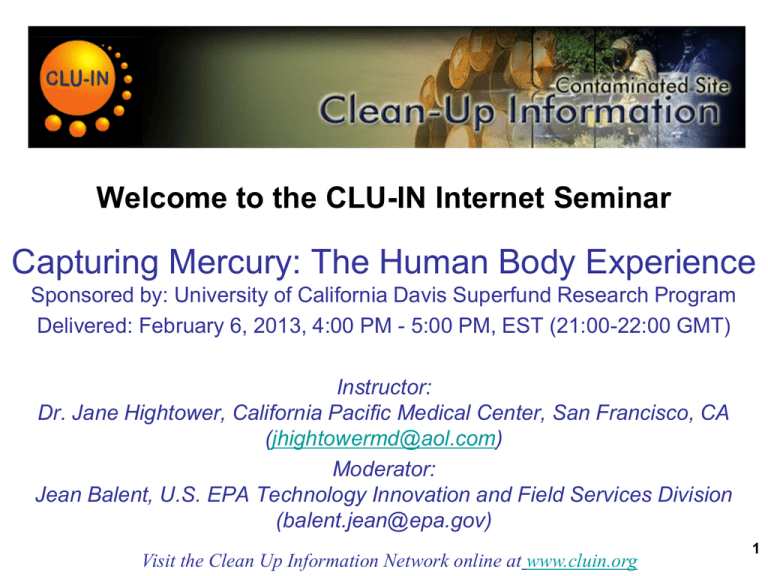
Welcome to the CLU-IN Internet Seminar Capturing Mercury: The Human Body Experience Sponsored by: University of California Davis Superfund Research Program Delivered: February 6, 2013, 4:00 PM - 5:00 PM, EST (21:00-22:00 GMT) Instructor: Dr. Jane Hightower, California Pacific Medical Center, San Francisco, CA (jhightowermd@aol.com) Moderator: Jean Balent, U.S. EPA Technology Innovation and Field Services Division (balent.jean@epa.gov) Visit the Clean Up Information Network online at www.cluin.org 1 Housekeeping • Entire broadcast offered live via Adobe Connect – participants can listen and watch as the presenters advance through materials live – Some materials may be available to download in advance, you are recommended to participate live via the online broadcast • Audio is streamed online through by default – Use the speaker icon to control online playback – If on phones: please mute your phone lines, Do NOT put this call on hold – press *6 to mute #6 to unmute your lines at anytime • Q&A – use the Q&A pod to privately submit comments, questions and report technical problems • This event is being recorded • Archives accessed for free http://cluin.org/live/archive/ 2 New online broadcast screenshot Enlarge presentation Control online audio View presentation live online here Submit private questions, comments or report technical problems Information about Sponsors & Speakers 3 Capturing Mercury The Human Body Experience Jane M. Hightower, MD California Pacific Medical Center San Francisco, CA 4 Diagnostic Nightmare of the human blood mercury safety level 2000 •Laboratory: Normal is less than 13 mcg/l at the end of a workweek. •Cecil’s Textbook of Medicine 1996: Normal is less than 50 mcg/l. •EPA: Less than 5.0 mcg/l. •NRC: Less than 5.0 mcg/l •Finnish men cardiac study <8.0 mcg/l •FDA: Undeclared? 200 mcg/l? 400? 5 Why Methylmercury is a Menace to Human Health 1. Mercury cannot be cooked out of the fish!! 2. Methylmercury is on average 95% absorbed when consumed. 3. It is taken up by all tissues 1-2 days after a single dose. 4. It can penetrate every cell in the body, where it can disrupt cell division and molecular pathways. 5. Half-life in blood for majority of adults is about two months. 6. Binds thiol groups 6 Fishing Industry Mantra There has never been a case of mercury poisoning from normal consumption of ocean-going fish in this country 7 Poison Middle English 13th century A substance that through its chemical action usually kills, injures, or impairs an organism Something destructive or harmful A substance that inhibits the activity of another substance or the course of a reaction or process 8 The Truth There has never been a blinded, placebo, controlled study, giving humans methylmercury, to discern the entire spectrum of adverse affects ever published 9 The Human Body Hard drive: DNA encoding system. Software included: Cell to cell signaling system programs--NF-Kappa B and notch signaling. Special software/firewall for intrusion prevention, firewall and antivirus: Glutathione, metallothionein, bacterial defense... 10 Nuclear Factor Kappa B The Master Switch Thiol protein complex that controls the transcription of DNA. Found in nearly all animal cell types. Involved in cellular responses to stimuli such as stress, cytokines, free radicals, ulatraviolet radiation, oxidized LDL, and bacterial or viral antigens. First responder to harmful cellular stimuli, where its binding to DNA affects gene expression. KF kappa B lays in wait in cytoplasm, therefore not active unless stimulated. Physiological responses: Inflammatory or immune response, a cell survival response, or cellular proliferation. Incorrect signaling/chronically active NF Kappa B leads to cancer, inflammation, autoimmune disease, infection, improper immune development. 11 Glutathione It is the most abundant intracellular thiol peptide. It contains one amino acid residue each of glutamic acid, cysteine, and glycine. Plays an important role in biological oxidationreduction processes and as a coenzyme. Key to breakdown/inactivation/protection against numerous toxicants to include methylmercury. Glutathione complexes with toxicants and escorts them from the body in feces and urine. The human body has to make it. 12 Metallothionein Family of thiol proteins that have the capacity to bind both physiological (zinc,copper, selenium) and xenobiotic (mercury, cadmium, silver, arsenic) heavy metals. May provide protection against metal toxicity. In humans, large quantities are produced primarily in the kidney and liver. 13 Methylmercury binds strongly to thiol compounds 14 Thiol •A thiol is a class of organic chemical compounds similar to the alcohols and phenols but containing a sulfur atom in place of the oxygen atom (sulfhydryl). •Thiol compounds (mercaptans) form strong complexes with many metal ions. •Many cofactors (important helper molecules) are thiols. •The term “mercaptan” was derived in 1835 from the Latin mercurium captans (capturing mercury) because it forms its strongest bond with mercury. 15 Important Thiols Nuclear Factor Kappa B(NF Kappa B) Glutathione Metallothionein 16 NF Kappa B and Mercury Mercury prevents NF Kappa B---DNA binding by mercaptide (S-H) bond formation. Mercury interferes with NF Kappa B’s ability to bond with DNA to receive proper signaling. Even at low levels of exposure. Inhibition of the NF Kappa B—DNA binding by mercury modulates cytokine expression and suppresses nitric oxide synthesis. Enhances the sensitivity of kidney cells to apoptotic stimuli which kidney cells are otherwise resistant. 17 Glutathione and Mercury Glutathione binds most strongly to mercury. Mercury is escorted from the body in urine and feces as glutathione conjugates. Glutathione keeps toxicants from causing cellular damage and stimulating NF Kappa B. 18 Is Selenium the fishing industry’s methylmercury repellant? •Ocean fish Se content is fairly uniform amongst fish species. •Methylmercury content can vary over 100 times between fish, even amongst the same species. •Se is an integral part of glutathione. It gets used up as glutathione is complexed with mercury to be eliminated from the body. •Se is tightly regulated in the human body. 19 Effects of Inorganic Selenium Administration in Methylmercury-induced Neurotoxicity in Mouse Cerebral Cortex Int J Dev Neurosci. 2010 Nov;28(7):631-7 Se is necessary for the expression of at lease 25 Se-dependent enzymes, including the powerful antioxidant glutathione peroxidase. Inorganic Se increased glutathione peroxidase and glutathione reductase activities and lipid peroxidation. MeHg significantly reduced glutathione peroxidase activity and this effect was not modified by sodium selenite. Apparent reduction of MeHg brain metal deposition elicited by Inorganic Se. Inorganic selenium was ineffective in preventing most of the MeHginduced brain biochemical alterations. “superfluous selenium accumulated in the brain could be more rapidly deleterious than MeHg itself” “The toxic effects elicited by sodium selenite, alone or in combination with mercury, should be considered when this compound is proposed as a potential protective therapy for MeHg poisoning.” 20 Selenium and Food Daily requirement 70 mcg/day Fish contains only selenomethionine. Brazil nuts contain predominantly selenomethionine but other forms as well. Exceeding the Tolerable Upper Intake Level of 400 micrograms per day can lead to selenosis. A dose of selenium as small as 5000 mcg per day can be lethal for many humans. Natural food sources high in selenium: Cereals, nuts (brazil nuts and walnuts), legumes (soybeans), animal products (beef, chicken, egg, cheese), seafood (tuna). Other selenium rich foods are oats, cods and turkey. Brazil nuts are among the very rich sources of selenium. Exercise caution with consumption of brazil nuts, as the selenium intake may reach to toxic level. Brazil nuts 1919mcg/100g or ~600 mcg/30g serving Mixed nuts 421mcg/100g or ~ 130 mcg/30g serving Tuna 80 mcg/100g or ~ 130 mcg/170g serving Turkey 36 mcg/100g or ~ 60 mcg/170g serving Chicken 28 mcg/100g or ~ 50 mcg/170g serving 21 Bottom Line Don’t waste your limited supply of the selenium/glutathione detox system on unnecessary toxicants such as MeHg. MeHg depletes glutathione. MeHg can also directly bind to organic and inorganic Se and therefore make Se unavailable for glutathione production. Depletion of glutathione leaves the body more susceptible to further toxicant exposure and to exposure to other toxicants that also go through the glutathione pathway. In all chronic disease, low or deficient glutathione levels are found. This can be organ specific. Too much mercury can then lead to NK Kappa B stimulation. Most diseases are found to be a result of NF Kappa B mis-signaling. 22 Longevity Game Quiescent but appropriately responsive NF Kappa B. Plenty of glutathione. Appropriate DNA for the environment you live in. 23 Living Organisms Must Balance Oxidant/Antioxidant Status A Pro inflammatory and anti inflammatory state is constantly oscillating in the human body 24 Humans are Not Created Equal Glutathione polymorphisms NF Kappa B polymorphisms Metallothionein polymorphisms Vitamin D Polymorphisms 25 Polymorphism Multiple/variable alleles of a gene within a population, usually expressing different phenotypes. Allows for the human population to survive as a whole in many environments. Some polymorphisms allow protection, and some increase susceptibility to a cell insult. Determines the expression of toxicity or disease. 26 Glutathione-S-Transferase polymorphism, metallothionein expression, and mercury levels among students in Australia Sci Total Environ. 2007.Oct 15;385(1-2):37-47. GST T1 and GST M1 deletion polymorphisms Hair mercury concentrations are significantly increased in persons with the double deleted genotype (GSTT1-/- and GSTM1-/-) compared to persons with the intact genotype (GST1+/+ and GSTM1+/+) 27 Interaction Between GSTM1/GSTT1 Polymorphism and Blood Mercury on Birth Weight. Environ Health Perspect. 2010 Mar;118(3):437-43 For Korean mothers with the GST T1 -/- and GST M+/+ genotype, elevated Hg levels in maternal blood during late pregnancy were associated with an increased risk of lower birth weight. For mothers with both null genotypes GST T1-/- and GST M1-/-, both maternal and cord blood Hg levels were associated with lower birth weight.(unclear mechanism). Intact genotype had no inverse relationship of mercury level and birth weight. No statistical difference in mercury levels between genotypes 28 Genetic influences on the retention of inorganic mercury. Arch Environ Occup Health. 2005 Jan-Feb;60(1): 17-23 Glutathione (GSH) production is mediated by glutamylcystein ligase (GCL) and conjugated by glutathione S transferases (GST) In elemental mercury vapor exposure of gold miners, the presence of the GCLM-588T allele was associated with increased blood, plasma, and urine mercury levels. GCLM-588T is associated with lower glutathione levels in plasma. Concluded that genotypes with decreased GSH availability for mercury conjugation affect the metabolism of inorganic mercury. 29 Genetic variation in glutathione-related genes and body burden of methylmercury Environ Health Perspect. 2008 Jun;116(6):734-9 Individuals with variant alleles for either GCLM-588T or GSTP1-114 had higher Ery-Hg compared with individuals with other genotypes but similar exposure. Ery-Hg rose with increasing age. This finding is probably explained by more than just higher fish consumption among elderly. Increasing age may also be associated with impairment of the metabolism of MeHg. Both GSH and GST levels have been shown to decrease with age. 30 Prenatal Methylmercury Exposure Hampers Glutathione Antioxidant System Ontogenesis and Causes Long-lasting Oxidative Stress in the Mouse Brain Toxicol Appl Pharmacol. 2008 Feb15;227(1):147-54 Pregnant mice were exposed to different levels of MeHg. After delivery, pups were killed at different time points. In control animals, cerebral GSH levels significantly increased over time during the postnatal period. Gestational MeHg exposure caused a dose-dependent inhibition of this developmental event. Even though the cerebral mercury concentration decreased to nearly basal levels at postnatal day 21, GSH levels, GPx and GR activities remained decreased in MeHg-exposed mice. Prenatal exposure to MeHg disrupts the postnatal development of the glutathione antioxidant system. 31 Immune Modulation and Mercury Mercury can stimulate autoantibodies in those genetically susceptible. Inorganic, ethylmercury and methylmercury are known to stimulate antibodies. Kidney glomerular, mesangial, and systemic vessel wall immune-complex deposits, antinuclear antibodies, antithyroglobulin and anti-thyroid peroxidase antibodies… 32 Methylmercury and Human Health Non-specific symptoms Cardiovascular disease/lipid peroxidation Decreased heart rate variability/tachycardia Hypertension Endothelial cell dysfunction Neuropsychiatric effects Infertility Autoimmune disease/autoantibodies/NF kappa b Opthalmologic effects. i.e. cataracts, saccades Fetal effects Increased susceptibility to other diseases? 33 Environmental Working Group Body Burden Projects EWG.org 10 American infants: Up to 358 chemicals were found in cord blood. 232 of them have been targets of regulatory action and government controls. One newborn had 191 individual chemicals. In all, EWG tested 186 individuals from cord blood, infants, children, and adults for 552 chemicals and have detected over 414. Because of the mercaptan reliance for detox, these will all be second in line to mercury for their elimination. 34 Sensitive Individuals Developing brains. Those with polymorphisms in any of the detox or protective pathways. Concurrent toxicants. Chemotherapy patients/cancer patients Autoimmune patients. Those genetically susceptible to cancer/autoimmune disease. Atherosclerosis/coronary artery disease. Gastrointestinal disease. Chronic infections/TB, MAC, HIV, Lyme. Transplant patients. 35 Poison Paracelsus (1493-1541): "All things are poison and nothing is without poison, only the dose permits something not to be poisonous." Do adverse effects determined at the cellular level, but not previously identified by epidemiology, still constitute a poison? Where do we draw the line on when the dose doesn’t make the poison? 36 Omega 3 Fatty Acids Increases the production of bioactive lipid mediators affecting cytokine-induced signal transduction. Directly interferes with the generation of reactive oxygen species (mostly hydrogen peroxide) that are directly or indirectly responsible for the activation of the nuclear transcription factor NF-Kappa B. A downstream anti-inflammatory. 37 Treatment Avoidance is first. Antioxidants that keep NF Kappa B in check. Mercury and antioxidant studies: Curcumin, DHA, quercetin, lycopene, alpha lipoic acid, Co Q 10. Boost glutathione. (By having the essential Amino acids in the diet). Do not use your glutathione up on known avoidable toxicants. Maintain a healthy assortment of gut bacteria. Chelation needs to be studied carefully to determine whether it can lower disease incidence in a population exposed to toxicants. Do not overdose on selenium supplements. 38 Mercury Monitoring Whole Blood Hair DMSA Challenge Nail Intracellular Calculating Exposure 39 Most Noted Recent Mercury Sources Coal-burning power plants. Mining. Waste incinerators, hospitals, Crematoria. Cement factories. Thimerosal. Chemical plants i.e. chlor-alkalai, fungicides, switches, florescent lights, gauges, electronics, etc. Shipwrecks, Spanish, WWII, Submarines. Volcanoes, Earthquakes, Geothermal vents Latex house paint until 1991. Artists paint. Amalgams for teeth. Mercurochrome, vaccines, homeopathy. 40 Fishing Industry Sponsored Researcher’s Opinion 1977 Anderson Trial Lead neurologist for the study opined, “children who were determined were mildly affected were children looking normal, running around, behaving normally. And only with the most minimal retardation. They were a little slower to walk, perhaps a little slower to talk. They had increased frequency of seizures compared to the control group. Their height was slightly shorter. Their head circumference was slightly smaller. These were all very, very, minimal effects.” 41 Action Level for Mercury in fish 1 mcg/g (ppm) Email to Sue Kwon of KPIX News from FDA official: 2008 “I will speak about how the FDA defines an ‘action level.’” “The action level is a nonbinding guidance that the FDA issues to establish a level of a contaminant that may be regarded as adulterated (illegal). The action level serves as guidance for the FDA but does not commit the FDA to take any action. The FDA action level was issued in 1979 based on data available at the time.” 42 Other Questions? 1) Are patients getting the message? 2) What knowledge gets transferred? 3) What are the nutritional recommendations physicians are suggesting? 4) What are dieticians suggesting? 43 Any More Ideas? 4000 mcg Hg/bulb on average iStockphoto.com http://www.npr.org/templates/story/story.php?storyId=7431198 http://www.energystar.gov/ia/partners/promotions/change_light/do wnloads/Fact_Sheet_Mercury.pdf 44 45 New Ways to stay connected! • Follow CLU-IN on Facebook, LinkedIn, or Twitter https://www.facebook.com/EPACleanUpTech https://twitter.com/#!/EPACleanUpTech http://www.linkedin.com/groups/Clean-UpInformation-Network-CLUIN-4405740 46 Resources & Feedback • To view a complete list of resources for this seminar, please visit the Additional Resources • Please complete the Feedback Form to help ensure events like this are offered in the future Need confirmation of your participation today? Fill out the feedback form and check box for confirmation email. 47

